Recommended Poker Room
If you have already multitabled poker tournaments such as Sit and Go’s or Double or Nothing’s, you will for certain already have thought about what the best layout of the poker tables on your computer screen is. The table setup becomes even more important when you masstable SGN’s (playing 12 or more tables simultaneously). Depending on the minimum table size, which is set by your poker room, and the resolution of your monitor, you should be able to arrange between 4 and 24 tables without overlap on your screen. In some cases, however, overlapping online poker tables makes sense when playing Texas Hold’em online, as we shall see below.
Three Ways to Arrange Your Online Poker SNG Tables
If you are a grinder, playing more than one poker table simultaneously, you have three basic options to choose from when arranging the poker tables on your PC screen:
- Tiled (arranging the tables from top left to bottom right without overlap)
- Cascaded (setting up the tables diagonally from top left to bottom right)
- Stacked (all tables are in the same place, only the top table is visible to you)
Let’s have a closer look at these three online poker table setups and discuss the benefits of each table setup.
Table Layout “Tiled”
When tiling the poker tables, you reduce or minimize their size and start arranging them from top left to bottom right on your PC screen. When the first row is completed, you start with the second row. Of course you can also arrange the tables in columns, filling your screen from top left to bottom left, then starting the next column again at the top of your screen.
This screenshot shows an example of the “Tiled” organization of the online poker tables:
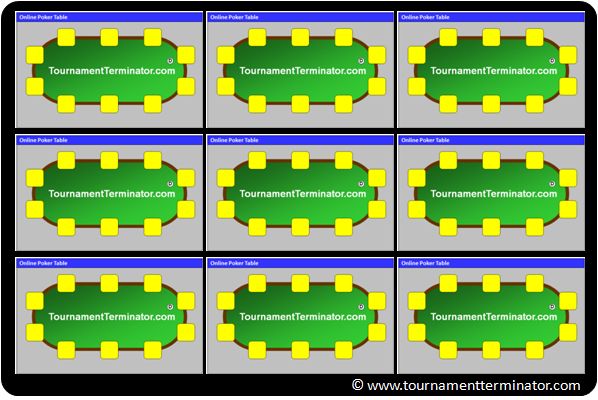
Advantages of the arrangement “Tiled”
- You always see all tables. This gives you the opportunity to participate in the game, even if you are not involved in a hand, giving you more reads on your opponents
- In addition, the learning effect for your own poker game is higher than with the other layouts: you can follow the results of your own actions (as for example, you can see whether you were successful with a blind steal or not)
- As most poker sites have a “Check / Fold” button, you can save time with the tiled setup: when there is no action at the tables, you can already mark tables with weak hole cards to auto-fold. This gives you more time to think about the more difficult situations
- The risk of misclicks, e.g. folding pocket Aces (because that table is just popping up when you wanted to fold your hand on another table) is very low, as the tables are separated from each other
- Playing online poker is more interesting because you can watch the action from beginning to end during a Sit&Go
Table Layout “Cascaded”
When using the cascaded layout, you arrange the poker tables from one corner of the screen diagonally to the opposite corner of the screen. Only the edges of the tables are visible:
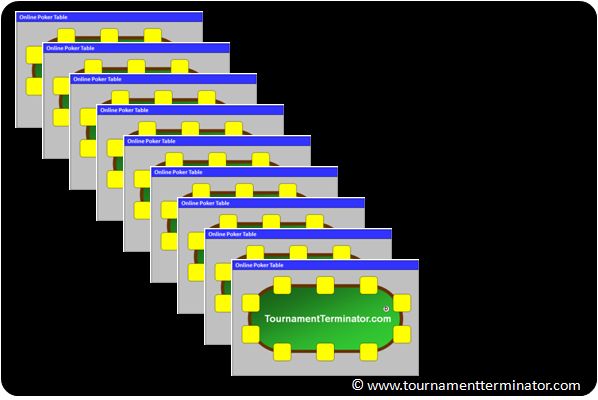
Advantages of the Setup “Cascaded”
- When cascading the tables, you save space on your screen thanks to the overlapping. You can therefore display much more tables than when using the tiled layout
- Since the tables are close to each other, the distance for the mouse pointer is short – this saves you time
- Although partly hidden, individual tables can be clicked on directly, as each table is visible. This is how you easily can watch how the action on a table continues: you simply drag and drop the table to a free space on the screen. After the hand was played, you draw the minitable back to its original position
- Due to the fact that you do not watch a lot of hands, the risk of going tilt is lower than when you tile the tables
- Furthermore, your play is less distracted from the action on the other tables
Table Layout “Stacked”
When stacking, all the tables are placed on the same spot on the screen. Some poker sites such as Party Poker allow you to have the table where you most urgently have to act popping up on top of the stack. This allows you to use the stacked setup of the poker tables: the active table is on top, covering all other tables completely:
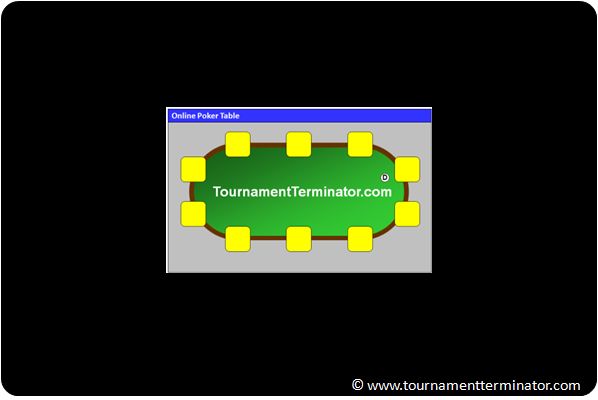
Advantages of the Table Setup “Stacked”
- When stacking the tables, you don’t use more space on your computer screen than a player who is only single-tabling
- This allows you to efficiently multitable on very small screens such as notebook or netbook screens, or allows you to display the tables in full size
- The distance for the mouse pointer is reduced to a minimum – this makes playing poker on notebooks without a mouse a very pleasant experience, and it reduces the strain on your wrist (ergonomics)
- By stacking your poker tables, you can masstable online poker. You can fully concentrate on the active table and you do not waste any time on the other tables or for finding the buttons to call, raise or fold. The well-known online pro “Boku87” uses this variant, playing up to 52 tables simultaneously
- As the tables can be displayed in large or original size, it is very easy to observe your hole cards and the board cards and to read the stats when using a HUD
Mixed Forms of Online Poker Table Arrangements
Of course you can combine the three basic options for the table setup while playing online poker with each other. These are the most common variations of the three basic table setups:
Tiled with Overlap
Especially new computer screens are designed for viewing videos in widescreen format. They are much broader than high. Just fill up your screen tiling the tables and overlap the bottom tables to make maximum usage of your screen size:
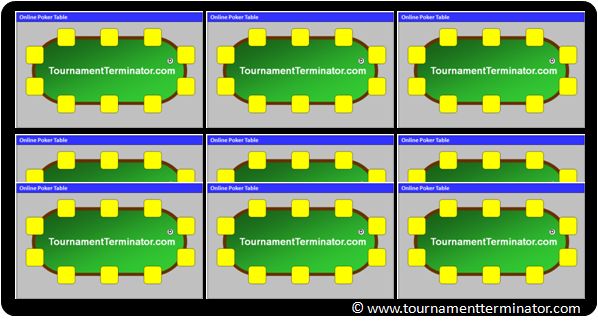
Multiple Cascades
Just add additional cascades of poker tables to your screen if one cascade is not enough:
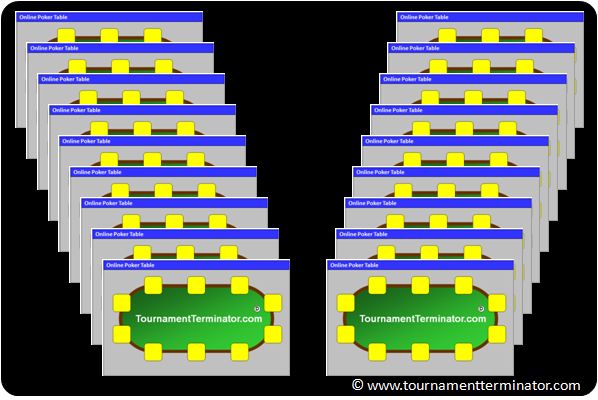
Multiple Stacks
Of course, you can also mix the stacked and the tiled layout, for example by building two, four or even six stacks consisting of 2 or more tables each:
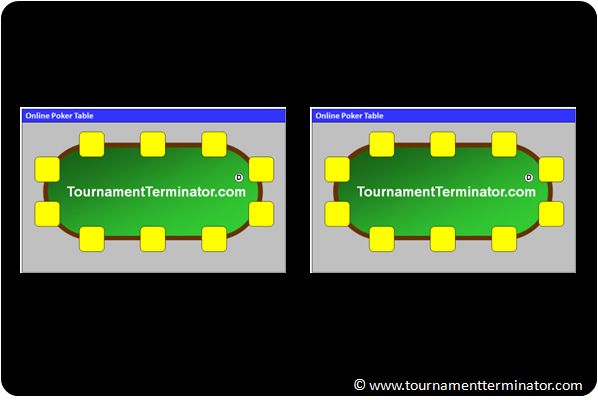
Table Setup: Multitabling Tipps
If you want to make a change to your arrangement of the poker tables after reading this poker strategy article, we recommend you to test the new method at the playmoney tables or at the micro-limit SNG tournaments.
Beginners should start with four tables and use the “Tiled” setup. This allows them to see what happens at the tables, and learn what the effects of their calls, bets and raises are. Only after at least 2,000 Sit and Go’s we recommend players to start playing more than six tables or to switch to another table layout on the screen.
Advanced players and pro grinders, who can pass on the learning effect by observing the tables, should play tournaments by cascading or stacking the tables. This allows them to play more tables at once, leading to an increased hourly rate.
The layout for the pros, stacked or cascaded, is supported by the software of Party Poker.
Sign up at Party Poker (use the bonus code TERMINATE for the maximum bonus of 400$ 500$) in order to play more tables per set, earning you higher profits per hour.
888 Poker has one of the easiest to beat player pools. Avoid the sharks on PokerStars, play where the fishes are!
>>Beat the Fish at 888 Poker Now! Get $88 free! <<
 www.
www.
